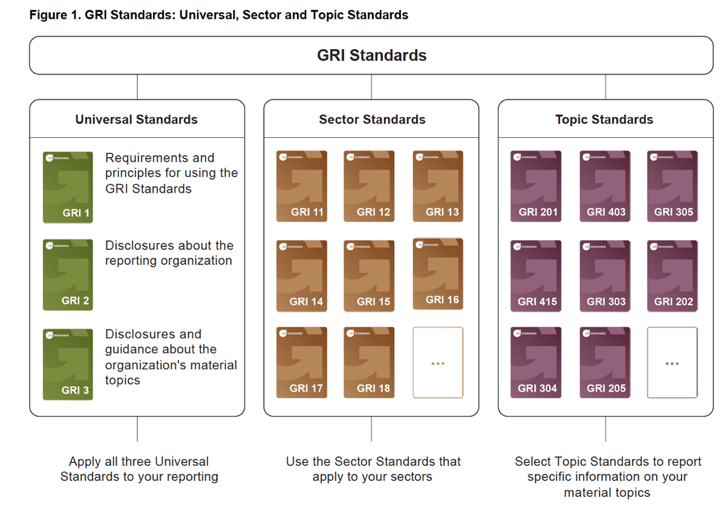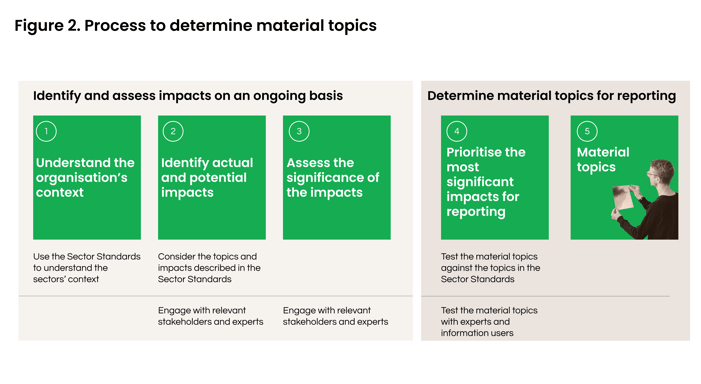A Guide To The GRI Reporting Standards

Introduction – Before getting started
Definition of Sustainability Reporting
According to the Global Reporting Initiative (GRI):
"Sustainability reporting is a process which starts with an organization determining its material topics based on its most significant impacts on the economy, on the environment, and on people, including its impacts on people's human rights".
What is GRI?
GRI is an independent, international organisation that develops reporting standards to support companies and organisations in externally communicating their sustainability efforts. The GRI Standards are the world’s most widely used for sustainability reporting.
Who should report?
As described on the GRI's website, the GRI Standards are suitable for any organisation, regardless of its size, type, country of operation, and reporting experience.
When should I start with GRI reporting?
The sooner you start identifying what you have to disclose, the easier it will be to draft your sustainability report. Indeed, you need to gather data to disclose specific indicators. Moreover, your company will have to conduct a materiality assessment and engage with stakeholders. These two steps are usually ongoing and time-consuming.
Why should I disclose?
Disclosing your sustainability efforts in line with the GRI Standards has various internal and external benefits for your organisation. According to GRI, the value of reporting can be summarised as follows:
Internal benefits
- Clear vision and strategy;
- Consistent performance measurement;
- Improved risk management;
- Higher motivation and employee engagement.
External benefits
- Improved goodwill and reduced reputational risks;
- Enhanced product image, brand name and trust;
- Higher capital attraction;
- Higher stakeholder engagement;
- Ensured regulatory compliance.
More concretely, reporting in accordance with the GRI Standards allows your organisation to:
- Align the sustainability report with other standards;
- Comply with recognised certifications such as EcoVadis or BCorp;
- Align with future regulations in the EU such as the CSRD;
- Compare your organisation's performance over time and against competitors.
The 2021 GRI Standards – What is new?
In 2021, GRI published new reporting standards. They will become mandatory for reports published after the 1st of January 2023. Nevertheless, we highly recommend already analysing them and even implementing them in your sustainability report.
This section provides an overview of the three main standards of GRI: Universal, Sector and Topic Standards (Figure 1).
 Source: GRI Foundation 2021
Source: GRI Foundation 2021
Universal Standards
GRI 1: Foundation 2021
GRI 1: Foundation explains the ‘why’ and ‘how’ of reporting against the GRI Standards. It highlights its purpose and the key principles to follow when reporting.
Additionally, it clarifies critical concepts, such as:
- Impact - the effect organisation's activities have or could have on the environment and society;
- Material topics - all those impacts an organisation prioritises, as they are identified as most significant for the organisation and its stakeholders.
- Due diligence - the process followed by the organisation to identify, prevent, and mitigate its negative impacts.
- Stakeholders - all those third parties that are affected by the organisation's activities.
Reporting "in accordance" vs "in reference"
Originally, organisations could choose to prepare a GRI Sustainability Report in accordance with the Standards under the Core or Comprehensive option.
With the new GRI Standards 2021, the only two options available are "in accordance" and "in reference".
Reporting "in accordance" with GRI
This option is the more strict one. In fact, it requires to comply with all the 9 requirements highlighted in the Standards. Specifically, the requirements are:
- Apply the reporting principles;
- Report on GRI 2: General Disclosures;
- Determine material topics;
- Report on GRI 3: Material Topics;
- Report on each material topic;
- When the organisation cannot comply with specific disclosures and/or requirements, provide the reason(s) for omission;
- Publish a GRI Content Index;
- Provide a Statement of Use;
- Notify GRI.
Reporting "in reference" to GRI
This is the more accessible option. Therefore, it could be the first step to take when deciding to use this framework. In this case, organisations are asked to:
- Comply with only three out of the nine requirements: (1) Publish a GRI content index; (2) Provide a statement of use; (3) Notify GRI;
- Apply the reporting principles explained below;
- Explain how material topics are managed (using GRI 3).
Reporting principles
The GRI Standards include a set of reporting principles to keep in mind when drafting the sustainability report. They aim to ensure a high-quality representation of the organisation's sustainability performance.
- Accuracy - the presented information is correct and sufficiently detailed;
- Balance - information is reported in an unbiased way and provides a fair representation of negative and positive impacts;
- Clarity - information is accessible and understandable;
- Comparability - information is selected, compiled and reported in a consistent manner ;
- Completeness - the level of information disclosed is sufficient to assess an organisation's impacts;
- Sustainability context - information about the organisation's impacts is depicted in the wider context of sustainable development;
- Timeliness - information has to be disclosed on a regular schedule and in time for decision-making purposes;
- Verifiability - the quality of disclosed information can be externally examined.
GRI 2 - General Disclosures 2021
GRI 2 – General Disclosures aims to represent the profile of the reporting entity by looking at the:
- Organisation and its reporting practices
- Activities and workers
- Governance
- Strategy, policies and practices
- Stakeholder engagement
GRI 3 - Material Topics 2021
GRI 3 – Material Topics provides guidance on how an organisation can determine its material topics, how to disclose them and the way they are managed.
A materiality analysis is a process through which an organisation can identify the most significant environmental and social impacts generated.
This section describes a step-by-step approach to conducting a materiality analysis (see Figure 2):
- Understand the organisation's context;
- Identify actual and potential impacts;
- Assess the significance of the impacts;
- Prioritise the most significant impacts for reporting.

According to GRI 3 - Material Topics, disclosure should include:
Disclosure 3-1: Process to define material topics
The reporting organisation has to disclose the process used to identify material topics, as well as to prioritise them.
Disclosure 3-2: List of the material topics
The organisation has to disclose the list of all the material topics identified through the materiality analysis. The results can be also presented in a sustainability materiality matrix, to be referenced in the content index.
Disclosure 3-3: Management of material topics
The organisation must describe the actual and potential, negative and positive impacts generated. For each of the material topics, the reporting entity must disclose actions implemented to manage the topic and its related impacts.
Sector standards
GRI is developing Sector Specific Standards for 40 industries, starting with those that generate the biggest impacts. They support reporting organisations in writing a sustainability report by defining material topics for the industry and key information to disclose.
Currently, the Sector Disclosures are available for the following sectors:
- GRI 11: Oil and Gas Sector 2021
- GRI 12: Coal Sector 2022
- GRI 13: Agriculture, Aquaculture and Fishing Sectors 2022
If your organisation falls into one of the above industries, you should use the Sector Standards to draft your sustainability report. You can access them from the GRI’s Resource Center.
If a specific standard is not yet available for your industry, you should select the Topics Standards relevant to your organisation.
Topic Standards
The GRI Topic Standards are used based on the material topics identified during the materiality analysis.
Each Standard contains an overview of what the reporting entity should disclose on that topic. Therefore, organisations should select those Topic Standards that correspond to their material topics and use them for reporting.
Below are some examples of Topics Standards:
- GRI 204: Procurement Practices 2016
- GRI 205: Anti-corruption 2016
- GRI 302: Energy 2016
- GRI 303: Water and Effluents 2018
- GRI 304: Biodiversity 2016
- GRI 306: Waste 2020
- GRI 403: Occupational Health and Safety 2018
- GRI 404: Training and Education 2016
- GRI 405: Diversity and Equal Opportunity 2016
- GRI 410: Security Practices 2016
- GRI 416: Customer Health and Safety 2016
Topic Standards are available in the GRI’s Resource Center as well.
Frequently Asked Questions
Is there a way to reference GRI or use it as guidance without publishing a GRI report?
Yes, you can report with reference to the GRI Standards (as opposed to in accordance with the Standards). While you still have to follow the eight reporting principles, you do not need to adhere to all nine reporting requirements. Instead, you only need to (1) Publish a GRI content index (2) Provide a statement of use (3) Notify GRI.
Is it mandatory to have the report certified by GRI in order to publish it with the GRI logo?
You do not need to have your GRI report certified to publish it with a GRI logo. You do have to follow the nine reporting requirements and the eight reporting principles. Once you prepare a sustainability report in accordance with the GRI standards, you have to notify the GRI.
Do the GRI and SASB standards have the same requirements in terms of conducting the materiality analysis?
With regard to materiality analysis, the two standards require that such an analysis is done. There are guidelines and suggestions on how to conduct it, but the actual steps are not a requirement. The requirement is to have done it and to describe the process.
Where can I find the GRI Standards 2021?
All resources can be found on the GRI website accessible via this link.
When will the GRI Standards 2021 become mandatory?
The 2021 Standards are in effect for reporting from 1 January 2023. As GRI encourages early adoption, you can already comply with them in your 2022 report.
In which case can I omit certain disclosure or requirements?
If the organisation cannot comply with a specific disclosure or requirement, a reason for the omission is needed. In particular, the organisation should highlight missing information in the content index and provide one of the four reasons for omission:
- Not applicable;
- Legal prohibitions, to be described;
- Confidentiality constraints;
- Unavailable or incomplete information.
How do I notify GRI about my report?
To notify GRI you can use the GRI Standards Report Registration System. Your submission may take some time to be processed but this will not affect your compliance with the notification requirement.
Do you need support with GRI Reporting?
